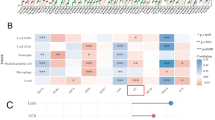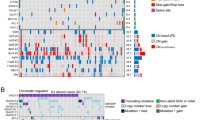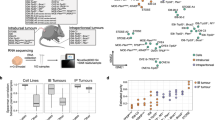Abstract
The molecular events that drive the initiation and progression of ovarian adenocarcinoma are not well defined. We have investigated changes in gene expression in ovarian cancer cell lines compared to an immortalized human ovarian surface epithelial cell line (HOSE) using a cDNA array. We identified 17 genes that were under-expressed and 10 genes that were over-expressed in the cell lines compared to the HOSE cells. One of the genes under-expressed in the ovarian cancer cell lines, Id3, a transcriptional inactivator, was selected for further investigation. Id3 mRNA was expressed at reduced levels in 6 out of 9 ovarian cancer cell lines compared to the HOSE cells while at the protein level, all 7 ovarian cancer cell lines examined expressed the Id3 protein at greatly reduced levels. Expression of Id3 mRNA was also examined in primary ovarian tumours and was found in only 12/38 (32%) cases. A search was conducted for mutations of Id3 in primary ovarian cancers using single stranded conformation polymorphism (SSCP) analysis. Only one nucleotide substitution, present also in the corresponding constitutional DNA, was found in 94 ovarian tumours. Furthermore no association was found between LOH at 1p36 and lack of expression of Id3. These data suggest that Id3 is not the target of LOH at 1p36. © 2001 Cancer Research Campaign http://www.bjcancer.com
Similar content being viewed by others
Article PDF
Change history
16 November 2011
This paper was modified 12 months after initial publication to switch to Creative Commons licence terms, as noted at publication
References
Blackwell TK and Weintraub H (1990) Differences and similarities in DNA-binding preferences of MyoD and E2A protein complexes revealed by binding site selection. Science 250: 1104–1110
Bruening W, Prowse AH, Schultz DC, Holgado-Madruga M, Wong A and Godwin AK (1999) Expression of OVCA1, a candidate tumour suppressor, is reduced in tumours and inhibits growth of ovarian cancer cells. Cancer Res 59: 4973–4983
Buick RN, Pullano R and Trent JM (1985) Comparative proterties of five human ovarian adenocarcinoma cell lines. Cancer Res 45: 3668–3676
Chenevix-Trench G, Leary J, Kerr J, Michel J, Kefford R, Hurst T, Parsons P, Friedlander M and Khoo SK (1992) Frequent loss of heterozygosity on chromosome 18 in ovarian adenocarcinoma which does not always include the DCC locus. Oncogene 7: 1059–1065
Deed RW, Hirose T, Mitchell ELD, Santibanez-Koref MF and Norton JD (1994) Structural organisation and chromosomal mapping of the human Id-3 gene. Gene 151: 309–314
Fogh J and Trempe G (1975) New human cell lines. In: Fogh J (ed). Human tumour cells in vitro, pp. 155–159., Plenum: New York
Foster KA, Harrington P, Kerr J, Russell P, DiCoccio RA, Scott IV, Jacobs I, Chenevix-Trench G, Ponder BAJ and Gayther SA (1996) Somatic and germline mutations of the BRCA2 gene in sporadic ovarian cancer. Cancer Res 56: 3622–3625
Hamilton TC, Young RC, McKoy WM, Grotzinger KR, Green JA, Chu EW, Whang-Peng J, Rogan AM, Green WR and Ozols RF (1983) Characterization of a human ovarian carcinoma cell line (NIH:OVCAR-3) with androgen and estrogen receptors. Cancer Res 43: 5379–5389
Imyanitov EN, Birrell GW, Filippovich I, Sorokina N, Arnold J, Mould M, Wright K, Walsh M, Mok SC, Lavin MF, Chenevix-Trench G and Khanna KK (1999) Frequent loss of heterozygosity at 1p36 in ovarian adenocarcinoma but the gene encoding p73 is unlikely to be the target. Oncogene 18: 4640–4642
Israel MA, Hernandez M-C, Florio M, Andres-Barquin PJ, Mantani A, Carter JH and Julin CM (1999) Id gene expression as a key mediator of tumour cell biology. Cancer Res 59: 1726s–1730s
Janssen JW, Schulz AS, Steenvoorden AC, Schmidberger M, Strehl S, Ambros PF and Bartram CR (1991) A novel putative tyrosine kinase receptor with oncogenic potential. Oncogene 6: 2113–2120
Kohler M, Janz I, Wintzer HO, Wagner E and Bauknecht T (1989) The expression of EGF receptors, EGF-like factors and c-myc in ovarian and cervical carcinomas and their potential clinical significance. Anticancer Res 9: 1537–1548
Kruk PA, Maines-Bandiera SL and Auersperg NA (1990) Simplified method to culture ovarian surface epithelium. Laboratory Investigation 63: 132–136
Langdon SP, Lawrie SS, Hay FG, Hawkes MM, McDonald A, Hayward IP, School DJ, Hilgers J, Leonard RCF and Smyth JF (1988) Characterization and properties of nine human ovarian adenocarcinoma cell lines. Cancer Res 48: 6166–6172
Leary JA, Kerr J, Chenevix-Trench G, Doris CP, Hurst T, Houghton CRS and Friedlander ML (1995) Increased expression of the NME1 gene is associated with metastasis in epithelial ovarian cancer. Int J Cancer 64: 189–195
Lee SW, Tomasetto C and Sager R (1991) Positive selection of tumour suppressor genes by subtractive hybridisation. Proc Natl Acad Sci USA 88: 2825–2829
Li S, MacLachlan TK, De Luca A, Claudio PP, Condorelli G and Giordano A (1995) The cdc-2-related kinase, PISSLRE, is essential for cell growth and acts in G2 phase of the cell cycle. Cancer Res 55: 3992–3995
Liang P and Pardee AB (1992) Differential display of eukaryotic messenger RNA by means of the polymerase chain reaction. Science 257: 967–971
Lin H, Huber R, Schlessinger D and Morin PJ (1999) Frequent silencing of the GPC3 gene in ovarian cancer cell lines. Cancer Res 59: 807–810
Lyden D, Young AZ, Zagzag D, Yan W, Garald W, O’Reilly R, Bader RO, Zhuang A, Manova K and Benezra R (1999) Id1 and Id3 are required for neurogenesis, angiogenesis and vascularization of tumour xenografts. Nature 401: 670–677
Mandai M, Konishi I, Kuroda H, Komatsu T, Yamamoto S, Nanbu K, Matsushita K, Fukumoto M, Yamabe H and Mori T (1998) Heterogeneous distribution of K-ras-mutated epithelia in mucinous ovarian tumours with special reference to histopathology. Hum Pathol 29: 34–40
Merajver SD, Pham TM, Caduff RF, Chen M, Poy EL, Cooney KA, Weber BL, Collins FS, Johnston C and Frank TS (1995) Somatic mutations in the BRCA1 gene in sporadic ovarian tumours. Nature Genetics 9: 439–443
Mielnicki LM, Hughes RG, Chevray PM and Pruitt SC (1996) Mutated ATF-4 suppresses c-Ha-ras oncogene transcript levels and cellular transformation in NIH3T3 fibroblasts. Biochem Biophys Res Comm 228: 586–595
Mok SC, Chan WY, Wong KK, Muto MG and Berkowitz RS (1996) SPARC, an extracellular matrix protein with tumour-suppressing activity in human ovarian epithelial cells. Oncogene 12: 1895–1901
Mok SC, Chan WY, Wong KK, Cheung KK, Lau CC, Ng SW, Baldini A, Colitti CV, Rock CO and Berkowitz RS (1998) DOC-2, a candidate tumour suppressor gene in human epithelial ovarian cancer. Oncogene 16: 2381–2387
Murre C, McCaw PS and Baltimore D (1989) A new DNA binding and dimerization motif in immunoglobulin enhancer binding, daughterless, in MyoD, and myc proteins. Cell 56: 777–783
Norton JD and Atherton GT (1998) Coupling of cell growth control and apoptosis functions of Id proteins. Mol Cell Biol 18: 2371–2381
Norton JD, Deed RW, Craggs G and Sablitzky F (1998) Id helix-loop-helix proteins in cell growth and differentiation. Trends Cell Biol 8: 58–65
Obata K, Morland SJ, Watson RH, Hitchcock A, Chenevix-Trench G, Thomas EJ and Campbell IG (1998) Frequent PTEN/MMAC mutations in endometrioid but not serous or mucinous epithelial ovarian tumours. Cancer Res 58: 2095–2097
O’Bryan JP, Frye RA, Cogswell PC, Neubauer A, Kitch B, Prokop C, Espinosa R, Le Beau MM, Earp HS and Liu ET (1991) ax1, a transforming gene isolated from primary human myeloid leukemia cells, encodes a novel receptor tyrosine kinase. Mol Cell Biol 11: 5016–5031
Parkin DM, Pisani P and Ferlay J (1999) Estimates of the worldwide incidence of 25 major cancers in 1990. Int J Cancer 80: 827–841
Peitu G, Alibert O, Guichard V, Lanny B, Bois F, Leroy E, Mariage-Samson R, Houlgatte R, Soularue P and Auffray C (1996) Novel gene transcripts preferentially expressed in human muscles revealed by quantitative hybridization of a high density cDNA array. Genome Res 6: 492–503
Ragnarrson G, Eiriksdottir G, Johannsdottir JT, Jonasson JG, Egilsson V and Ingvarsson S (1999) Loss of heterozygosity at chromosome 1p in different solid human tumours: association with survival. Br J Cancer 79: 1468–1474
Ruoslahti E (1996) Integrin signalling and matrix assembly. Tumour Biol 17: 117–124
Sager R (1997) Expression genetics in cancer: shifting the focus from DNA to RNA. Proc Natl Acad Sci USA 94: 952–955
Sambrook J, Fritch EF and Maniatis T (1989). Molecular cloning: A laboratory manual, second edition. Cold Spring Harbor Laboratory Press: New York
Schena M, Shalon D, Davis RW and Brown PO (1995) Quantitative monitoring of gene expression patterns with a complementary DNA microarray. Science 270: 467–470
Schummer M, Ng WV, Bumgarner RE, Nelson PS, Schummer B, Bednarski DW, Hassel L, Baldwin RL, Karlan BY and Hood L (1999) Comparative hybridisation of an array of 21 500 ovarian cDNAs for the discovery of genes overexpressed in ovarian carcinomas. Gene 238: 375–385
Shelling AN, Cooke IE and Ganesan TS (1995) The genetic analysis of ovarian cancer. Br J Cancer 72: 521–527
Shih Y, Kerr J, Liu J, Hurst T, Khoo S, Ward B, Wainwright B and Chenevix-Trench G (1997) Rare mutations and no hypermethylation at the CDKN2A locus in epithelial ovarian tumours. Int J Cancer 70: 508–511
Slamon DJ, Godolphin W, Jones LA, Holt JA, Wong SG, Keith DE, Levin WJ, Stuart SG, Udove J, Ullrich A and Press MF (1989) Studies of the HER-2/neu proto-oncogene in human breast and ovarian cancer. Science 244: 707–712
Tsao S-W, Mok SC, Fey EG, Fletcher JA, Wan TSK, Chew E-C, Muto MG, Knapp RC and Berkowitz RS (1995) Characterization of human ovarian surface epithelial cells immortalized by human papilloma viral oncogenes (HPV-E6E7 ORFs). Exp Cell Res 218: 499–507
Vasmatzis G, Essand M, Brinkmann U, Lee B and Pastan L (1998) Discovery of three genes specifically expressed in the human prostate by expressed sequence tag database analysis. Proc Natl Acad Sci USA 95: 300–304
Velculescu VE, Zhang L, Vogelstein B and Kinzler KW (1995) Serial analysis of gene expression. Science 270: 484–487
Wang K, Gan L, Jeffery E, Gayle M, Gown AM, Skelly M, Nelson PS Ng WV, Schummer M, Hood L and Mulligan J (1999) Monitoring gene expression profile changes in ovarian carcinomas using cDNA microarray. Gene 229: 101–108
Ward BG, Wallace K, Shepherd JH and Balkwill FR (1987) Intraperitoneal xenografts of human epithelial ovarian cancer in nude mice. Cancer Res 47: 2662–2667
Wilson AP (1984) Characterization of a cell line derived from the ascites of a patient with papillary serious cystadenocarcinoma of the ovary. J Natl Cancer Inst 72: 513–520
Wilson AP, Ford CHJ, Newman CE and Howell A (1987) Cis -platinum and ovarian carcinoma: in vitro chemosensitivity of cultured tumour cells from patients receiving high dose cis -platinum as first line treatment. Br J Cancer 56: 763–773
Wolf CR, Hayward IP, Lawrie SS, Buckton K, McIntyre MA, Adams DJ, Lewis AD, Scott ARR and Smyth JF (1987) Cellular heterogeneity and drug resistance in two ovarian adenocarcinoma cell lines derived from a single patient. Int J Cancer 39: 695–702
Wong AST, Maines-Bandiear SL, Rosen B, Wheelock MJ, Johnson KR, Leung PCK, Roskelley CD and Auersperg N (1999) Constitutive and conditional cadherin expression in cultured human ovarian surface epithelium: influence of family history on ovarian cancer. Int J Cancer 81: 180–188
Woods LK, Morgan RT, Quinn LA, Moore GE, Semple TU and Stedman KE (1979) Comparison of four new cell lines from patients with adenocarcinoma of the ovary. Cancer Res 39: 4449–4459
Wright K, Wilson P, Morland S, Campbell I, Walsh M, Hurst T, Ward B, Cummings M and Chenevix-Trench G (1999) Beta-catenin mutation and expression analysis in ovarian cancer: exon 3 mutations and nuclear translocation in 16% of endometrioid tumours. Int J Cancer 82: 625–629
Yasue H, Takeda A and Ishibashi M (1987) Amplification of the c-myc gene and the elevation of its transcripts in human ovarian tumour lines. Cell Struct Funct 12: 121–126
Yu Y, Xu F, Peng H, Fang X, Zhao S, Li Y, Cuevas B, Kuo W-L, Gray JW, Siciliano M, Mills GB and Blast, Jr RC (1999) NOEY2 (ARH1), an imprinted putative tumour supressor gene in ovarian and breast carcinomas. Proc Natl Acad Sci USA 96: 412–219
Zhou DJ, Gonzalez-Cadavid N, Ahuja H, Battifora H, Moore GE and Cline MJ (1988) A unique pattern of proto-oncogene abnormalities in ovarian adenocarcinomas. Cancer 62: 1573–1579
Author information
Authors and Affiliations
Rights and permissions
From twelve months after its original publication, this work is licensed under the Creative Commons Attribution-NonCommercial-Share Alike 3.0 Unported License. To view a copy of this license, visit http://creativecommons.org/licenses/by-nc-sa/3.0/
About this article
Cite this article
Arnold, J., Mok, S., Purdie, D. et al. Decreased expression of the Id3 gene at 1p36.1 in ovarian adenocarcinomas. Br J Cancer 84, 352–359 (2001). https://doi.org/10.1054/bjoc.2000.1620
Received:
Revised:
Accepted:
Published:
Issue date:
DOI: https://doi.org/10.1054/bjoc.2000.1620
Keywords
This article is cited by
-
Effects of upregulation of Id3 in human lung adenocarcinoma cells on proliferation, apoptosis, mobility and tumorigenicity
Cancer Gene Therapy (2015)
-
Id proteins expression in prostate cancer: high-level expression of Id-4 in primary prostate cancer is associated with development of metastases
Modern Pathology (2006)
-
The impact of genomic alterations on the transcriptome: a prostate cancer cell line case study
Chromosome Research (2006)
-
Id family of helix-loop-helix proteins in cancer
Nature Reviews Cancer (2005)
-
Reduced expression of chemokine (C-C motif) ligand-2 (CCL2) in ovarian adenocarcinoma
British Journal of Cancer (2005)



